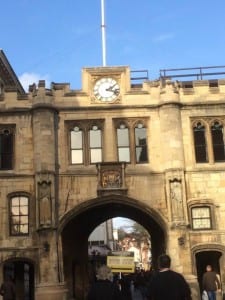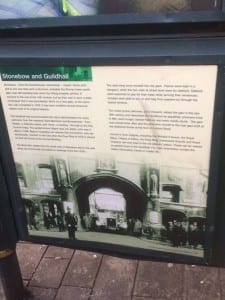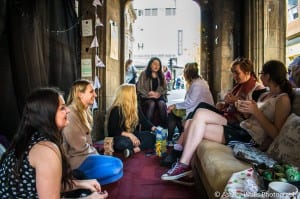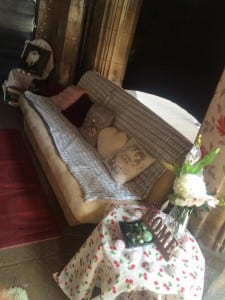Our Underlying Principal
Our class’ chosen site was the Lincoln high street. Mike Pearson quotes Patrice Pavis describing how to choose a site. “A large part of the work has to do with researching a place, often an unusual one that is imbued with history or permeated with atmosphere: an airplane hangar, unused factory, city neighbourhood, house or apartment.” (Pavis, 7, 2010) Following Pavis’ guidance on researching into a site with historical context, we chose the Stone Bow archways in the town centre. (See Fig. 1) We chose this site because collectively, we were inspired by Marc Augé’s idea of places and non-places and believed the archways could be considered as both. Augé describes what he believes a place and a non-place to be: “If a place can be identified as relational, historical and concerned with identity, then a space which cannot be defined as relational, or historical, or concerned with identity will be a non-place.” (Augé, 77, 1995) He also states “…places and non-places intertwine and tangle together… Thus we can contrast the realities of transit… with those of residence or dwelling…” (Augé, 107, 1995) After researching into Augé, we believed that the archways were to be considered a ‘non-place’, due to the amount of people using it, as he described, as a place of transit. Furthermore many people had little knowledge about its rich historical background. I believe it is a neglected space on the high street, when it can be so easily be identified as a ‘place’. Therefore this concept of a transforming a ‘non-place’ into a ‘place’ was the underlying principle of our final piece.
 Fig. 1 (Olivia Calvert, 2016) – The Archways
Fig. 1 (Olivia Calvert, 2016) – The Archways
There’s Non-Place Like Home
Our final performance date was Thursday 5th May 2016 and our space, as already stated, was under the Stone Bow Archways on Lincoln high street. Primarily, we wanted to explore Augé’s notion of places and non-places and to challenge our own and audiences’ perceptions of what having a ‘home’ meant. Also what it might mean to others, namely the homeless. As the archways are a form of shelter, we thought it would be the perfect place to set up a stereotypical home setting. The historical context of it previously featuring as a jail, only added to our conversation topic and we were able to explore possible binaries such as feeling safe/unsafe. The initial set up of the household took around 3 hours to design and that in itself turned into part of our performance as it attracted so much attention from the public. Even setting up, we were already getting responses from passers-by of their own thoughts about what makes a home for them. However, our main intention was to have an invited audience come into our space so we could talk to them about their lives and the concept of home. Meanwhile being in a make-shift house on the high street. We wanted to make them feel comfortable, as though they were actually at home, serving tea and biscuits as well. This was so we could exchange information in the most free and natural way possible.
Analysis of Process
Once we had been introduced to various theorists and their relevant works, we split off into our performance groups to discuss any possible ideas beginning to form. Rolo, Holly and I each swapped ideas of what we wanted to include in the performance and tried to accommodate everyone’s interests. For example, I liked the idea of having an end product from the work we produce, whether this was something we made collectively, or a product which the audience would make. Our first idea we ran with was about the social change from the top to the bottom of the high street. This was an idea we all found interesting from a previous class discussion around it. I felt we could incorporate relevant issues that go on in Lincoln, such as the litter problem, making the piece more current. Also we discussed about comparing the type and the amount of litter from the bottom to the top of the high street to see if there was any comparison. However, this was our first attempt of devising a piece. Once we had exhausted this idea, we moved onto another. We found this a useful way to develop our ideas because we were starting to explore issues which led us to homelessness.
Our second idea which we all preferred, was based on Marc Augé’s work on places and non-places. This idea came from another discussion we all found interesting in class prior to this group meeting, about whether the high street is a place or a non-place. We immediately thought of the archways on the high street as a starting location because it is a place of constant transit for the public to get from one side to the other. (See Fig 2) It is also the part of the high street everyone remembers, yet know little about. Continuing with this new idea and discussing issues prior such as littering, we thought about the homeless, another big problem in Lincoln. We also discussed how a homeless person could regard the arches as their home, therefore transforming it into a ‘place’. As homelessness is such a big issue in Lincoln, creating a piece which is not only relevant to the site but to the city itself, enables us to connect to the city ourselves. Sophie Calle is a performance artist whose work Suite Vénitienne (2015) had similar themes to our idea of connecting ourselves to the city. “Feeling dislocated from her native city, she began to walk the streets with her camera…”(Waldron, 2012) This piece of work involved her trying to connect to the city of Paris, through photography and following people. Taking inspiration from this piece of work we thought about connecting with people via a conversation, rather than through a camera.
Fig 2 Lincoln Archway Passers-by (Holly Lomas, 2016)
Week four was when we were introduced to Adrian Howells’ work, which had a great influence on our final piece. The video we saw of him was called Salon Adrienne. It featured Adrian as his persona ‘Adrienne’ in an actual salon, washing and blow drying members of the public’s hair and giving them an Indian head massage. Whilst he was doing this, he was talking very openly with the person participating, confessing certain things in his life and inviting them to confess something to him too. He was using techniques of relaxation and intimacy to encourage deep conversations. Dee Heddon speaks about the type of work Adrian creates. “…Adrian Howells has made a significant contribution to his confessional performance landscape, creating and touring performances which he confides in strangers, hoping in turn, that they will share details with him.” (Heddon and Howells, 2011, 1) This was where our idea of inviting the audience in for an exchangeable chat began. His work inspired us to interact with the audience in a similar way, by sharing our ideas about the concept of home and seeing if we can get a response from the audience. At this time, our main aim of the piece was to connect ourselves to the city, by bringing strangers on the high street together through conversations about what and where they consider home to be, and why.
By this point in the process, we were definite about using the archways as our site. Therefore, we desperately needed to research the area, its historical context and start asking the public what qualities they think makes up a home. This was important so we could start thinking about what props we needed to build the house. We split off into groups, Franki, Hannah and Rolo designed questions to ask the public to gather this research. An example question was: ‘what drink reminds you of home?’ We wanted to ask such question to gather responses from the public to help us shape our piece and to make it as homely as possible. The responses gathered helped us a lot because we found out that tea was in fact the most popular choice and as a result we decided to serve it in our performance. Whilst they were asking the public these types of questions, Holly and I analysed the site for a bit. We did a sound recording of the site for 2 minutes. (See Fig 3) We did not pick up any sounds out of the ordinary, only snippets of conversations and the sounds of footsteps which strengthened our claim that it was indeed a non-place. After we had gathered all the relevant material from this initial research group, we decided to find out about its historical background. We all knew the archways were very old and obviously served a purpose in their time, however we did not know much more information. Therefore, we explored this context further. Firstly we found a poster advertising free tours of the Guildhall (the building above the archways) and thought this would be very beneficial for us to go to. Before we went on the tour, we wanted to see if we could find any basic information so we could go already fuelled with some possible questions. This was when we discovered an information board not far from the site, explaining in detail the origin and purpose of the archways. (See Fig 4) We found out the Stone Bow Archways had been there since the Viking times, but needed repairing and were re-built in 1520. Also, that there was a bell which had been rung since the 1370’s to summon councillors to meetings. This specific fact was something that we were all intrigued by. One question which we wanted to ask the tour guide was whether the bell was still working and if we could somehow incorporate it into our piece by featuring it as a doorbell. Reading on, we also found out that the archways served as a prison for felons. Once we had read up on our historical context, it was time for the tour. Our tour guide was very knowledge about the Guildhall and the Stone Bow Archways. We were able to find out that the bell was in working order and is still regularly used. Therefore we had the opportunity to make use of it for our performance. He also took us round to where the prisoners would have been held. Overall, the tour was very insightful to our piece as we now saw our site in a new light, with possible new ideas to add to our piece involving the jail.
Fig 3. Archway Noise (Holly Lomas, 2016)

Fig 4. Information Board (Olivia Calvert, 2016)
Nearing the end of the process, our main idea was to build a make-shift home on the high street, invite people in and discuss what the notion of ‘home’ meant to them through an exchangeable conversation. We would serve tea and biscuits to our audience, trying to make them feel as comfortable as possible, mirroring Adrian Howells’ techniques on relaxation to encourage natural conversation. However, we began to doubt our ideas and were not sure that we were engaging with the site’s history enough and that we were relying too much on audience participation. We were then encouraged by our tutor to incorporate ideas to do with the jail into our piece. To help us in the right direction Steve showed us a video called ‘On the Scent’ by a group called Curious. It was a piece very similar to ours, with the idea of inviting people into a home style setting and having them interact with the performer. Only the performer was making the audience members feel a bit awkward by invading their personal space and acting inappropriately. After watching this video we hesitantly decided to adjust our ideas to combine the idea of a jail into our house setting. From this we devised a 10 minute piece to show both Conan and Steve. Each of us had a different role in the performance and we played with the idea of repetition, mirroring the life of an inmate. Our role was to make the audience member feel awkward and uncomfortable, despite the homely surroundings to represent life in a prison. We also explored binaries and how a prison can be interpreted as a place/non-place, safe/unsafe and how the house like setting contrasts with a prison. However, before even being told, we knew this idea was very muddled and Conan advised us to go back to our original idea of interacting with our audience in a natural way and to be ourselves – which we were all glad about. Therefore we pressed on with buying relevant props to adorn our home. Our main focus was to make sure the set looked accurate and to make people feel comfortable. We each bought a variety of different props with us to decorate the site, including material to section off the arches. This was important as it enclosed the space we were working in, forgetting that we were indeed on the high street.
Evaluation
Our final performance named There’s Non-Place Like Home went better than I imagined it would. Throughout the process we were nervous about the audience’s reaction and whether we would gather any audience participation, but surprisingly the public were all for it. They were even starting conversations with us and giving their opinions about ‘home’ and homelessness. The tea and biscuits only enticed more people in. It turned out that building the set itself became a performance, which we were not expecting. Therefore, we had a great number of incidental audience members checking out what was going on. Because of this, I believe the biggest strength of our piece was the final product, the set. (See Fig 5, 6, and 7) I believe that our make shift home looked very realistic with the sofa and with appropriate decorations in the site. Using the material to segregate the space really made the set feel secluded from the high street. Although, if we had to do it again, I would be inclined to put the material up in a different way to how we did on the day. We had a lot of problems with it falling down and therefore it posed as a distraction from our intention of creating a homely atmosphere for our audience members. Also, another aspect I would change, would be taking advantage of the Guildhall bell. There was an opportunity to use it, incorporating more historical context into our piece which we did not do. Additionally, the assessed performance did not happen the way we intended it to. We all had specific questions ready to ask the audience about ‘home’ but instead, we talked about our devised piece of site specific theatre. It became much more relaxed and we were each able to talk about what home meant to us individually which I actually preferred.
Overall, this process has opened my eyes to a new type of performance. By being able to engage with a space other than a stage, has showed me how interactive a piece of theatre can be. Not only through the use of audience participation, but by the performer connecting to the site itself. Nick Kaye sums up that a piece of art, does not have to happen on stage. “…A work of art, too, will refer to its place and position.” (Kaye, 2000, 1)
Fig. 5 Final Set (Olivia Calvert, 2016)
Fig.6 Tour of Our Final Set (Holly Lomas, 2016)

Fig.7 Interaction in our set (Ashley Walls, 2016)
Word Count: 2661
Bibliography
Augé, M. (1995) Non-places Introduction to an Anthropology of Supermodernity. London: Verso.
Calvert, O. (2016) There’s Non-Place Like Home. [Fig. 1, 4, 5] Lincoln: Stone Bow Arches
Heddon, D. and Howells, A. (2011) From Talking to Silence: a Confessional Journey. A Journal of Performance and Art. 33, 1-12. Available from: http://eprints.gla.ac.uk/54210/1/54210.pdf [Accessed 12/5/16]
Kaye, N. (2000) Site Specific Art. USA: Routledge.
Lomas, H. (2016) There’s Non-Place Like Home. [Fig.2,3,6] Lincoln: Stone Bow Arches.
Pearson, M. (2010) Site Specific Performance. Basingstoke: Palgrave.
Walls, A. (2016) There’s Non-Place Like Home. [Fig. 7] Lincoln: Stone Bow Arches.
Waldron, S. (2012) Sophie Calle – Suite Vénitienne and the Hotel. Point 101. Available From: http://blog.point101.com/blog/2012/10/29/sophie-calle-suite-vnitienne-and-the-hotel [Accessed 12/5/16]
